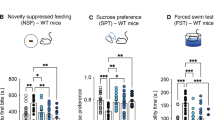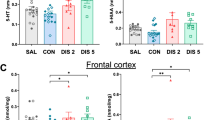Abstract
Drugs, notably SSRIs, that elevate brain extracellular 5-HT (5-HTExt) are antidepressants. Unfortunately, most patients fail to remit. Multipronged clinical evidence suggests that elevating 5-HTExt beyond the SSRI effect enhances antidepressant efficacy, but previous such drug strategies had prohibitive limitations. In humans, adjunct treatment with the 5-HT precursor 5-hydroxytryptophan (5-HTP) elevates 5-HTExt beyond the SSRI effect. Small pilot trials suggest that adjunct 5-HTP can confer antidepressant response in treatment-resistant depression (TRD). However, sustained, stable 5-HTExt elevation is required for antidepressant effect; therefore, the rapid absorption and elimination of standard 5-HTP immediate release (IR) likely curtail 5-HTP IR’s antidepressant potential. Slow-release (SR) drug delivery can crucially improve efficacy and safety of rapidly absorbed and eliminated compounds. Here we tested in mice the hypothesis that SR delivery will substantially improve 5-HTP’s drug properties, by minimizing adverse effects and securing sustained 5-HTExt elevation beyond the SSRI effect. We modeled 5-HTP SR with minipumps, 5-HTP IR with injections, and chronic SSRI with dietary fluoxetine. We tested adjunct 5-HTP SR in wild-type mice and in mice with low brain 5-HT owing to expression of a mutant form of the brain 5-HT synthesis enzyme, tryptophan hydroxylase 2. In both lines of mice, adjunct 5-HTP SR synergized with SSRI to elevate 5-HTExt beyond the SSRI effect. We observed no adverse effect. Adjunct 5-HTP IR could not produce this therapy-like profile, producing transient 5-HTExt spikes and marked adverse effects. Integrated with a body of clinical data, our mouse data suggest that an adjunct 5-HTP SR drug could safely and effectively elevate 5-HTExt beyond the SSRI effect and represent a novel treatment for TRD.
Similar content being viewed by others
Log in or create a free account to read this content
Gain free access to this article, as well as selected content from this journal and more on nature.com
or
References
Aan Het Rot M, Zarate CA Jr, Charney DS, Mathew SJ (2012). Ketamine for depression: where do we go from here? Biol Psychiatry 72: 537–547.
Baumann P, Ulrich S, Eckermann G, Gerlach M, Kuss HJ, Laux G et al (2005). The AGNP-TDM Expert Group Consensus Guidelines: focus on therapeutic monitoring of antidepressants. Dialogues Clin Neurosci 7: 231–247.
Beaulieu JM, Zhang X, Rodriguiz RM, Sotnikova TD, Cools MJ, Wetsel WC et al (2008). Role of GSK3 beta in behavioral abnormalities induced by serotonin deficiency. Proc Natl Acad Sci USA 105: 1333–1338.
Bender DA (1983). Biochemistry of tryptophan in health and disease. Mol Aspects Med 6: 101–197.
Benton CS, Miller BH, Skwerer S, Suzuki O, Schultz LE, Cameron MD et al (2012). Evaluating genetic markers and neurobiochemical analytes for fluoxetine response using a panel of mouse inbred strains. Psychopharmacology 221: 297–315.
Berman RM, Cappiello A, Anand A, Oren DA, Heninger GR, Charney DS et al (2000). Antidepressant effects of ketamine in depressed patients. Biol Psychiatry 47: 351–354.
Blakely RD, Berson HE, Fremeau RT Jr, Caron MG, Peek MM, Prince HK et al (1991). Cloning and expression of a functional serotonin transporter from rat brain. Nature 354: 66–70.
Bohets H, Annaert P, Mannens G, Van Beijsterveldt L, Anciaux K, Verboven P et al (2001). Strategies for absorption screening in drug discovery and development. Curr Top Med Chem 1: 367–383.
Broer S (2008). Amino acid transport across mammalian intestinal and renal epithelia. Physiol Rev 88: 249–286.
Brooks BR, Thisted RA, Appel SH, Bradley WG, Olney RK, Berg JE et al (2004). Treatment of pseudobulbar affect in ALS with dextromethorphan/quinidine: a randomized trial. Neurology 63: 1364–1370.
Celada P, Bortolozzi A, Artigas F (2013). Serotonin 5-HT1A receptors as targets for agents to treat psychiatric disorders: rationale and current status of research. CNS Drugs 27: 703–716.
Collado PS, Munoz ME, Esteller A, Gonzalez J (1988). Phenolsulphonphthalein conjugation and biliary excretion in the rat: influence of phenobarbital and 3-methylcholanthrene. Arch Int Physiol Biochim 96: 17–23.
Croom KF, Wellington K (2006). Modified-release nifedipine: a review of the use of modified-release formulations in the treatment of hypertension and angina pectoris. Drugs 66: 497–528.
Daws LC (2009). Unfaithful neurotransmitter transporters: focus on serotonin uptake and implications for antidepressant efficacy. Pharmacol Ther 121: 89–99.
Delgado PL (2006). Monoamine depletion studies: implications for antidepressant discontinuation syndrome. J Clin Psychiatry 67 (Suppl 4): 22–26.
Ebert D, Albert R, May A, Stosiek I, Kaschka W (1995). Combined SSRI-RIMA treatment in refractory depression. Safety data and efficacy. Psychopharmacology 119: 342–344.
Fernstrom JD, Wurtman RJ (1971). Brain serotonin content: physiological dependence on plasma tryptophan levels. Science 173: 149–152.
Fox MA, Jensen CL, French HT, Stein AR, Huang SJ, Tolliver TJ et al (2008). Neurochemical, behavioral, and physiological effects of pharmacologically enhanced serotonin levels in serotonin transporter (SERT)-deficient mice. Psychopharmacology 201: 203–218.
Gijsman HJ, van Gerven JM, de Kam ML, Schoemaker RC, Pieters MS, Weemaes M et al (2002). Placebo-controlled comparison of three dose-regimens of 5-hydroxytryptophan challenge test in healthy volunteers. J Clin Psychopharmacol 22: 183–189.
Green AR, Aronson JK, Curzon G, Woods HF (1980). Metabolism of an oral tryptophan load. I: Effects of dose and pretreatment with tryptophan. Br J Clin Pharmacol 10: 603–610.
Griebel G, Simiand J, Serradeil-Le Gal C, Wagnon J, Pascal M, Scatton B et al (2002). Anxiolytic- and antidepressant-like effects of the non-peptide vasopressin V1b receptor antagonist, SSR149415, suggest an innovative approach for the treatment of stress-related disorders. Proc Natl Acad Sci USA 99: 6370–6375.
Griebel G, Stemmelin J, Scatton B (2005). Effects of the cannabinoid CB1 receptor antagonist rimonabant in models of emotional reactivity in rodents. Biol Psychiatry 57: 261–267.
Hawley CJ, Quick SJ, Ratnam S, Pattinson HA, McPhee S (1996). Safety and tolerability of combined treatment with moclobemide and SSRIs: a systematic study of 50 patients. Int Clin Psychopharmacol 11: 187–191.
Hensler JG (2003). Regulation of 5-HT1A receptor function in brain following agonist or antidepressant administration. Life Sci 72: 1665–1682.
Hirano K, Seki T, Sakai N, Kato Y, Hashimoto H, Uchida S et al (2005). Effects of continuous administration of paroxetine on ligand binding site and expression of serotonin transporter protein in mouse brain. Brain Res 1053: 154–161.
Holladay JW, Dewey MJ, Yoo SD (1998). Pharmacokinetics and antidepressant activity of fluoxetine in transgenic mice with elevated serum alpha-1-acid glycoprotein levels. Drug Metab Dispos 26: 20–24.
Insel TR (2012). Next-generation treatments for mental disorders. Sci Transl Med 4: 155ps119.
Jacobsen JP, Medvedev IO, Caron MG (2012a). The 5-HT deficiency theory of depression: perspectives from a naturalistic 5-HT deficiency model, the tryptophan hydroxylase 2Arg439His knockin mouse. Philos Trans R Soc Lond B Biol Sci 367: 2444–2459.
Jacobsen JP, Siesser WB, Sachs BD, Peterson S, Cools MJ, Setola V et al (2012b). Deficient serotonin neurotransmission and depression-like serotonin biomarker alterations in tryptophan hydroxylase 2 (Tph2) loss-of-function mice. Mol Psychiatry 17: 694–704.
Kirsch I, Deacon BJ, Huedo-Medina TB, Scoboria A, Moore TJ, Johnson BT (2008). Initial severity and antidepressant benefits: a meta-analysis of data submitted to the Food and Drug Administration. PLoS Med 5: e45.
Kola I, Landis J (2004). Can the pharmaceutical industry reduce attrition rates? Nat Rev Drug Discov 3: 711–715.
Leichsenring F, Leibing E, Kruse J, New AS, Leweke F (2011). Borderline personality disorder. Lancet 377: 74–84.
Lopez-Munoz F, Alamo C (2009). Monoaminergic neurotransmission: the history of the discovery of antidepressants from 1950s until today. Curr Pharm Des 15: 1563–1586.
Lowe SL, Yeo KP, Teng L, Soon DK, Pan A, Wise SD et al (2006). L-5-Hydroxytryptophan augments the neuroendocrine response to a SSRI. Psychoneuroendocrinology 31: 473–484.
Magnussen I, Engbaek F (1978). The effects of aromatic amino acid decarboxylase inhibitors on plasma concentrations of 5-hydroxytryptophan in man. Acta Pharmacol Toxicol (Copenh) 43: 36–42.
Mischoulon D, Price LH, Carpenter LL, Tyrka AR, Papakostas GI, Baer L et al (2014). A double-blind, randomized, placebo-controlled clinical trial of S-adenosyl-L-methionine (SAMe) versus escitalopram in major depressive disorder. J Clin Psychiatry 75: 370–376.
Nagakura Y, Naitoh Y, Kamato T, Yamano M, Miyata K (1996). Compounds possessing 5-HT3 receptor antagonistic activity inhibit intestinal propulsion in mice. Eur J Pharmacol 311: 67–72.
Nardini M, De Stefano R, Iannuccelli M, Borghesi R, Battistini N (1983). Treatment of depression with L-5-hydroxytryptophan combined with chlorimipramine, a double-blind study. Int J Clin Pharmacol Res 3: 239–250.
NIMH (2012). FAST: Fast-Fail Trials. NIH, Bethesda, MD, USA (http://www.nimh.nih.gov/research-priorities/research-initiatives/fast-fast-fail-trials.shtml).
Papakostas GI, Shelton RC, Zajecka JM, Etemad B, Rickels K, Clain A et al (2012). l-Methylfolate as adjunctive therapy for SSRI-resistant major depression: results of two randomized, double-blind, parallel-sequential trials. Am J Psychiatry 169: 1267–1274.
Perry KW, Fuller RW (1993). Extracellular 5-hydroxytryptamine concentration in rat hypothalamus after administration of fluoxetine plus L-5-hydroxytryptophan. J Pharm Pharmacol 45: 759–761.
Sanchez C, Bergqvist PB, Brennum LT, Gupta S, Hogg S, Larsen A et al (2003). Escitalopram, the S-(+)-enantiomer of citalopram, is a selective serotonin reuptake inhibitor with potent effects in animal models predictive of antidepressant and anxiolytic activities. Psychopharmacology 167: 353–362.
Sargent PA, Williamson DJ, Cowen PJ (1998). Brain 5-HT neurotransmission during paroxetine treatment. The Br J Psychiatry 172: 49–52.
Sharp T, Boothman L, Raley J, Queree P (2007). Important messages in the 'post': recent discoveries in 5-HT neurone feedback control. Trends Pharmacol Sci 28: 629–636.
Siesser WB, Sachs BD, Ramsey AJ, Sotnikova TD, Beaulieu JM, Zhang X et al (2013). Chronic SSRI treatment exacerbates serotonin deficiency in humanized Tph2 mutant mice. ACS Chem Neurosci 4: 84–88.
Stahl SM (2008). L-methylfolate: a vitamin for your monoamines. J Clin Psychiatry 69: 1352–1353.
Thombre AG (2005). Assessment of the feasibility of oral controlled release in an exploratory development setting. Drug Discov Today 10: 1159–1166.
Trivedi MH, Rush AJ, Wisniewski SR, Nierenberg AA, Warden D, Ritz L et al (2006). Evaluation of outcomes with citalopram for depression using measurement-based care in STAR*D: implications for clinical practice. Am J Psychiatry 163: 28–40.
Turner EH, Loftis JM, Blackwell AD (2006). Serotonin a la carte: supplementation with the serotonin precursor 5-hydroxytryptophan. Pharmacol Ther 109: 325–338.
Uutela P, Reinila R, Harju K, Piepponen P, Ketola RA, Kostiainen R (2009). Analysis of intact glucuronides and sulfates of serotonin, dopamine, and their phase I metabolites in rat brain microdialysates by liquid chromatography-tandem mass spectrometry. Anal Chem 81: 8417–8425.
van Praag HM (1982). Serotonin precursors in the treatment of depression. Adv Biochem Psychopharmacol 34: 259–286.
Walinder J, Skott A, Carlsson A, Nagy A, Bjorn-Erik R (1976). Potentiation of the antidepressant action of clomipramine by tryptophan. Arch Gen Psychiatry 33: 1384–1389.
Werling LL, Keller A, Frank JG, Nuwayhid SJ (2007). A comparison of the binding profiles of dextromethorphan, memantine, fluoxetine and amitriptyline: treatment of involuntary emotional expression disorder. Exp Neurol 207: 248–257.
Whale R, Terao T, Cowen P, Freemantle N, Geddes J (2010). Pindolol augmentation of serotonin reuptake inhibitors for the treatment of depressive disorder: a systematic review. J Psychopharmacol 24: 513–520.
Author information
Authors and Affiliations
Corresponding author
Additional information
Supplementary Information accompanies the paper on the Neuropsychopharmacology website
Supplementary information
Rights and permissions
About this article
Cite this article
Jacobsen, J., Rudder, M., Roberts, W. et al. SSRI Augmentation by 5-Hydroxytryptophan Slow Release: Mouse Pharmacodynamic Proof of Concept. Neuropsychopharmacol 41, 2324–2334 (2016). https://doi.org/10.1038/npp.2016.35
Received:
Revised:
Accepted:
Published:
Issue date:
DOI: https://doi.org/10.1038/npp.2016.35
This article is cited by
-
The Effect of Lactobacillus casei Consumption in Improvement of Obsessive–Compulsive Disorder: an Animal Study
Probiotics and Antimicrobial Proteins (2020)
-
Slow-release delivery enhances the pharmacological properties of oral 5-hydroxytryptophan: mouse proof-of-concept
Neuropsychopharmacology (2019)
-
Serotonin concentration enhancers at clinically relevant doses reduce [11C]AZ10419369 binding to the 5-HT1B receptors in the nonhuman primate brain
Translational Psychiatry (2018)



